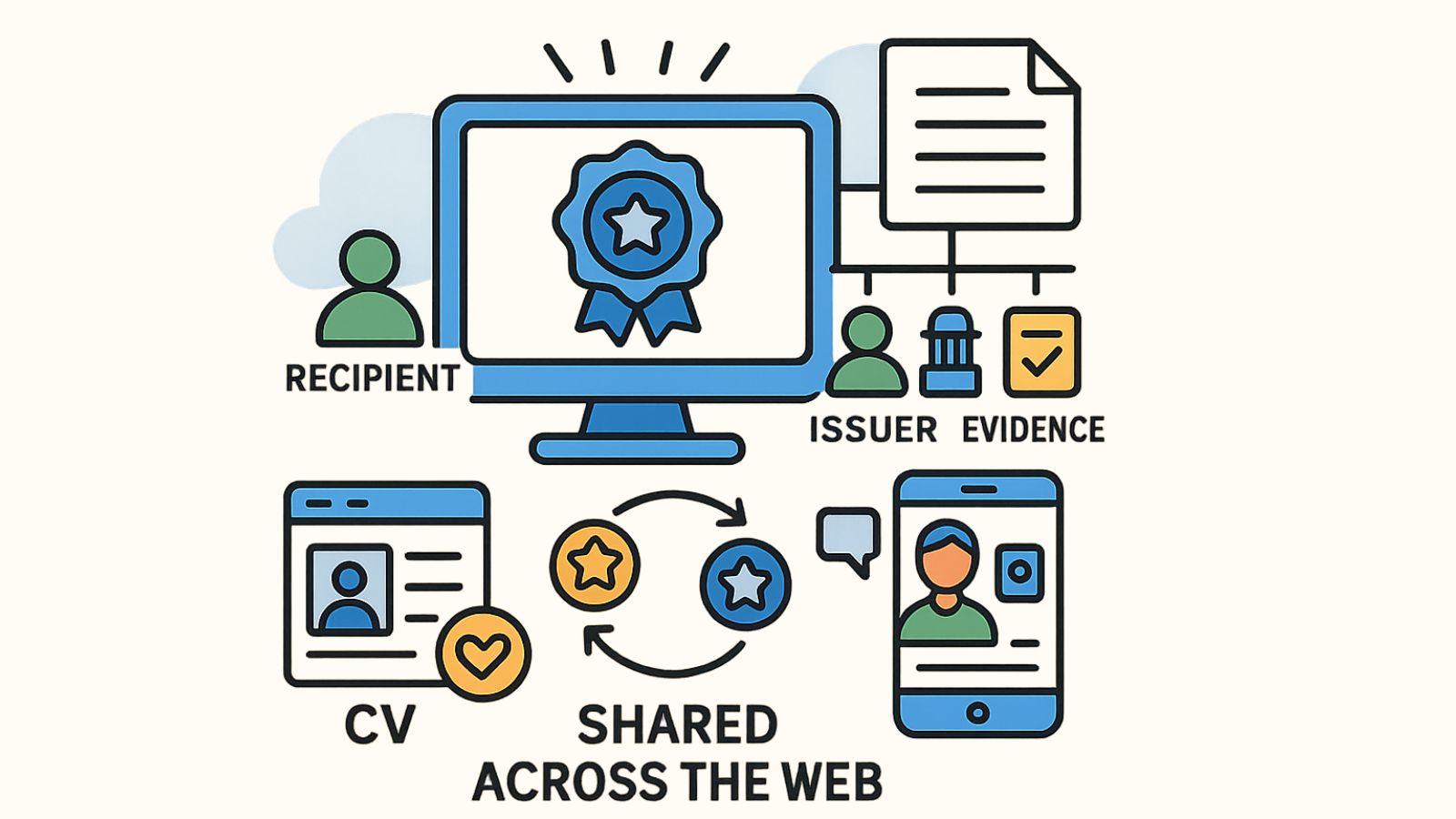For the better part of a decade, LinkedIn reigned supreme as the digital stage for professional identity. It was where learners pinned their new certifications, employers validated them, and recruiters scrolled through endless profiles looking for the next great fit. But as digital credentials have evolved into richer, verifiable records of achievement, a quiet revolution is underway.
In 2025, learners are rethinking how, where, and why they display their credentials. The goal is no longer just to appear qualified but to tell a story of growth that feels human, interactive, and authentic. A LinkedIn profile can still be the curtain call, but the real performance now unfolds across personal websites, digital wallets, immersive experiences, and even casual communication tools.
Digital credentials have become dynamic, living representations of one’s learning journey. They are proof, context, and conversation starter all at once. And as the Open Badges ecosystem and verifiable credential standards mature, learners are gaining full control over how they present their skills to the world. Here’s how they’re getting creative.
Personal Portfolios That Tell a Story
Gone are the days of static resumes that flatten a career into bullet points. Learners are now building digital portfolios that weave credentials into a narrative. A badge is no longer just a symbol; it’s a gateway to the story behind the skill.
Instead of saying “I completed a leadership program,” learners can now show the evidence: projects, reflections, peer reviews, and even videos of them in action. When someone clicks a badge on their portfolio, they see verifiable proof: who issued it, when it was earned, what the criteria were, and what the recipient actually did to earn it.
These portfolios are often built using flexible platforms like Notion, Webflow, or Squarespace, allowing creators to embed credentials directly into their pages. The design can be sleek and minimalist or deeply interactive, but the principle is the same: context matters.
Example: A UX designer might showcase their Hyperstack badges as part of a timeline illustrating their professional growth. One badge links to a case study of an accessibility redesign. Another opens a client testimonial. A third shows a video walkthrough of their design thinking process. Each badge acts as both evidence and ornament, creating a portfolio that feels alive.
What makes this approach powerful is authenticity. A recruiter or client is not just reading a claim; they are exploring the journey behind it.
Curious about building a verifiable digital portfolio? Explore how Hyperstack badges can turn your achievements into interactive stories.
Start here, schedule a free demo now→
Digital Wallets and Learning Passports
If 2024 was the year credentials became interoperable, 2025 is the year they became mobile. Learners are adopting digital credential wallets, secure spaces that hold all their verified achievements. Think of them as a cross between a resume, a passport, and a personal archive.
These wallets, powered by standards like Open Badges and Verifiable Credentials, let learners move their badges freely between systems. A credential earned in one institution can be recognized, verified, and displayed anywhere else, without re-issuance or manual uploads.
This is especially transformative for global learners and professionals who cross borders frequently. Whether you’re a nurse trained in India, a developer upskilling in Germany, or a teacher pursuing micro-credentials online, your learning passport travels with you..
This system reduces friction while increasing transparency. It also democratizes recognition, allowing informal and non-traditional learning experiences to carry weight across formal environments. Your badge for completing a community-driven coding bootcamp can now stand proudly beside your university degree. Both verifiable, both portable and meaningful.
Smart Email Signatures and Business Cards
Credentials are quietly finding their way into everyday professional communication. An email signature might seem like a small detail, but in a world where most introductions still happen digitally, it has become a subtle place to showcase credibility.
Professionals are embedding clickable credential icons or verification links into their signatures. A small badge beside your name can lead directly to proof of your qualification, adding trust and professionalism without requiring any extra explanation.
Similarly, digital business cards are becoming more interactive. QR codes on cards now lead to verifiable profiles or wallets where badges and certifications are displayed in real time. Some professionals even use NFC-enabled cards that open their digital credential page when tapped on a phone.
In 2025, your credentials no longer live on a separate platform. They accompany you in the micro-moments where trust is built.
Embedded in Content and Communities
Credibility is not only about what you know, but how you share it. As professionals increasingly build thought leadership online, digital credentials are becoming woven into the fabric of their content.
Writers, educators, and creators are embedding badges directly into blogs, newsletters, and community pages, giving readers transparent access to the expertise behind the words. It’s a small addition with big impact. The difference between “self-proclaimed expert” and “verified professional.”
Example: A sustainability coach ends her Substack article with a small icon of her environmental certification. Clicking it opens a verification page showing who issued it, when it was earned, and what learning outcomes it covered. The gesture is subtle yet reassuring. It turns credibility into something readers can check; without assumptions.
In online communities, badges are also becoming social signals. Some learning platforms now integrate verifiable badges directly into user profiles or discussion boards. When someone contributes insight to a forum, their verified badges appear beside their name. The result is a culture of transparent expertise, where knowledge-sharing feels both open and accountable. A Mindshare loop effect, exponentially spreads out into relative professional circles, promoting mutual growth wherever recognized.
For learners, this visibility does more than validate competence; it builds trust and belonging in professional ecosystems.
The concept also aligns perfectly with the ethos of lifelong learning: continuous, modular, and intrinsically motivating.
Micro-Websites and Credential-First Pages
Some professionals are going one step further by creating credential-first micro-sites, dedicated spaces that highlight their verified achievements front and center. Unlike traditional resumes that summarize experience, these sites allow users to explore every credential in depth, backed by evidence and media.
This trend is particularly strong among freelancers and consultants who want to showcase their credibility to clients. It also works for learners applying to programs or scholarships, where transparent evidence of achievement can make an application stand out.
Credential-first pages act as digital passports that are beautifully designed, instantly verifiable, and entirely under the learner’s control.
Employers are catching up too. Many organizations now allow candidates to submit verifiable credentials directly through job portals. Instead of uploading PDFs or typing out qualifications, applicants simply share badge links. The HR system automatically verifies authenticity, saving time and reducing fraud.

Some companies are integrating badges into internal recognition systems, allowing employees to earn and display credentials within the workplace. This encourages continuous learning while keeping achievement visible.
This evolution of verification from self-reported to system-verified is shaping a more transparent professional ecosystem where learning can be proven, not just claimed.
Physical Spaces Meet Digital Proof
Interestingly, the digital badge movement is circling back to the physical world. Conferences, learning fairs, and workshops are using QR-based credentials that bridge the gap between in-person participation and digital recognition.
Example: Attendees at a professional summit receive a scannable badge at registration. Once scanned, it links to their verified learning outcomes for that event, recorded in real time and stored in their credential wallet. The experience connects learning moments across contexts, creating a seamless record of growth.
This approach is expanding in education as well. Some institutions print scannable badges on certificates or ID cards, allowing instant digital verification for employers or peers. It’s a hybrid approach that makes credentials tangible while keeping their verification digital and future-ready.
Want to showcase your credentials beyond traditional platforms? Create and verify your own Open Badges with Hyperstack.
Get started by scheduling a free demo today→
A New Era of Visibility
What ties all these trends together is a shift in mindset. The question is no longer “Where should I post my credentials?” but “How can I give them meaning?”
Learners are no longer content with platforms that flatten achievements into static symbols. They want expression, flexibility, and ownership. They want to show why a skill matters, not just that it exists.
Open Badges and platforms like Hyperstack are enabling this shift by ensuring that credentials remain verifiable, portable, and interoperable across the web. They empower learners to own their proof of learning, to present it anywhere, and to keep it relevant as technology evolves.

In 2025, digital credentials are not just displayed. They are designed, curated, and upheld. Each badge becomes a brushstroke in the larger portrait of who you are and what you stand for.
LinkedIn will always have its place, but the future of showcasing achievement is more creative, more decentralized, and far more human. The learners who embrace this evolution are not just collecting badges, they are rather building living portfolios of growth that no algorithm can flatten into a single headline.
Because credibility today is not about where you list your achievements. It’s about how you bring them to life.
FAQs: Digital Credentials in 2025
1. What makes Open Badges different from regular digital certificates?
Open Badges include verified metadata such as issuer, recipient, criteria, and evidence, making them portable and trustworthy across platforms. A traditional certificate is static; an Open Badge is verifiable.
2. Can anyone issue an Open Badge?
Yes. Any organization or educator can issue an Open Badge, provided it meets the Open Badges Specification for metadata and verification. Platforms like Hyperstack make this process simple and compliant.
3. Are Open Badges accepted by employers?
Increasingly, yes. Employers value badges for their verifiability and detailed proof of skills. Many companies integrate badge verification into their hiring systems.
4. Where can I display my badges?
Badges can be embedded in portfolios, resumes, social profiles, digital wallets, or even email signatures. You can also link them to QR codes on business cards or physical certificates.
5. How secure are digital credentials?
They are cryptographically verified using open standards, ensuring that the data cannot be tampered with. This makes them more secure than traditional paper certificates.
6. Can I combine multiple badges from different issuers?
Absolutely. The open nature of the standard allows learners to collect and display badges from different sources in one cohesive digital wallet or portfolio.
7. What role does Hyperstack play in this ecosystem?
Hyperstack provides a modern platform for issuing, managing, and verifying Open Badges. It ensures compliance with global standards while offering flexibility and creativity in how credentials are designed and displayed.
8. Why should learners move beyond LinkedIn?
LinkedIn remains useful, but it’s limited in storytelling. Modern learners use badges across personalized and interactive environments where context, authenticity, and design take center stage.